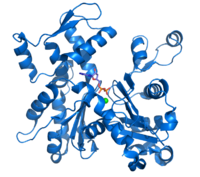
Photo from wikipedia
Although the distinct distribution of certain molecules along the anterior or posterior edge is essential for directed cell migration, the mechanisms to maintain asymmetric protein localization have not yet been… Click to show full abstract
Although the distinct distribution of certain molecules along the anterior or posterior edge is essential for directed cell migration, the mechanisms to maintain asymmetric protein localization have not yet been fully elucidated. Here, we studied a mechanism for the distinct localizations of two Dictyostelium talin homologues, talin A and talin B, both of which play important roles in cell migration and adhesion. Using GFP fusion, we found that talin B, as well as its C-terminal actin-binding region, which consists of an I/LWEQ domain and a villin headpiece domain, was restricted to the leading edge of migrating cells. This is in sharp contrast to talin A and its C-terminal actin-binding domain, which co-localized with myosin II along the cell posterior cortex, as reported previously. Intriguingly, even in myosin II-null cells, talin A and its actin-binding domain displayed a specific distribution, co-localizing with stretched actin filaments. In contrast, talin B was excluded from regions rich in stretched actin filaments, although a certain amount of its actin-binding region alone was present in those areas. When cells were sucked by a micro-pipette, talin B was not detected in the retracting aspirated lobe where acto-myosin, talin A, and the actin-binding regions of talin A and talin B accumulated. Based on these results, we suggest that talin A predominantly interacts with actin filaments stretched by myosin II through its C-terminal actin-binding region, while the actin-binding region of talin B does not make such distinctions. Furthermore, talin B appears to have an additional, unidentified mechanism that excludes it from the region rich in stretched actin filaments. We propose that these actin-binding properties play important roles in the anterior and posterior enrichment of talin B and talin A, respectively, during directed cell migration.
Journal Title: PLoS ONE
Year Published: 2019
Link to full text (if available)
Share on Social Media: Sign Up to like & get
recommendations!